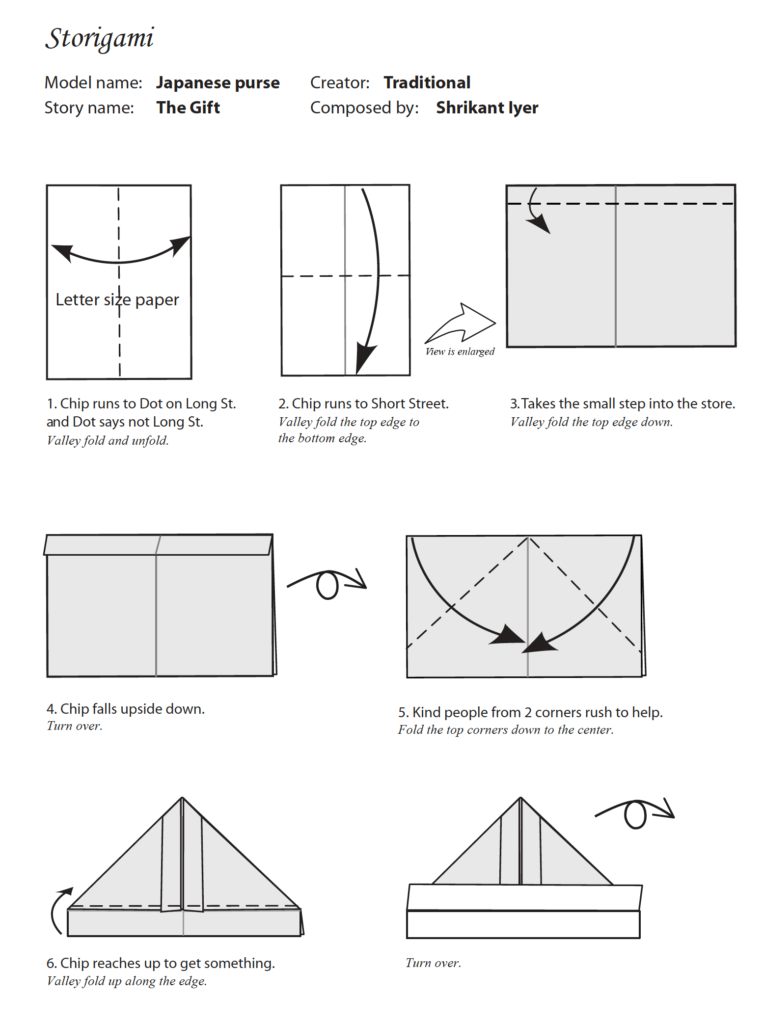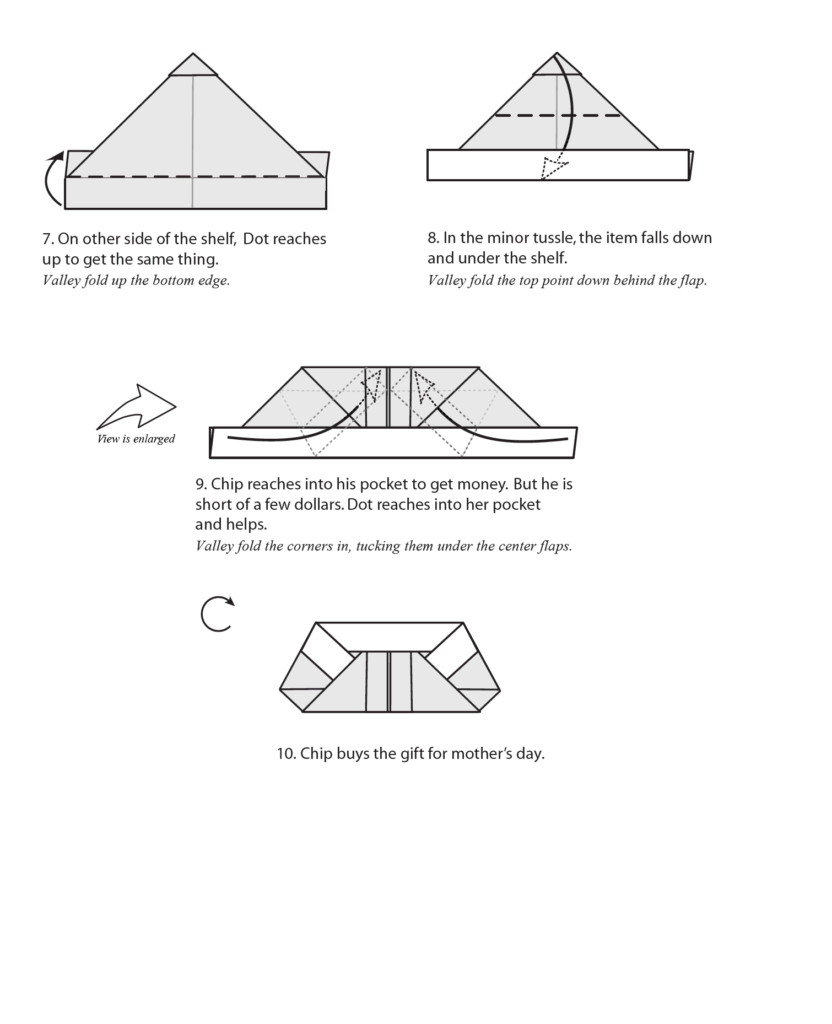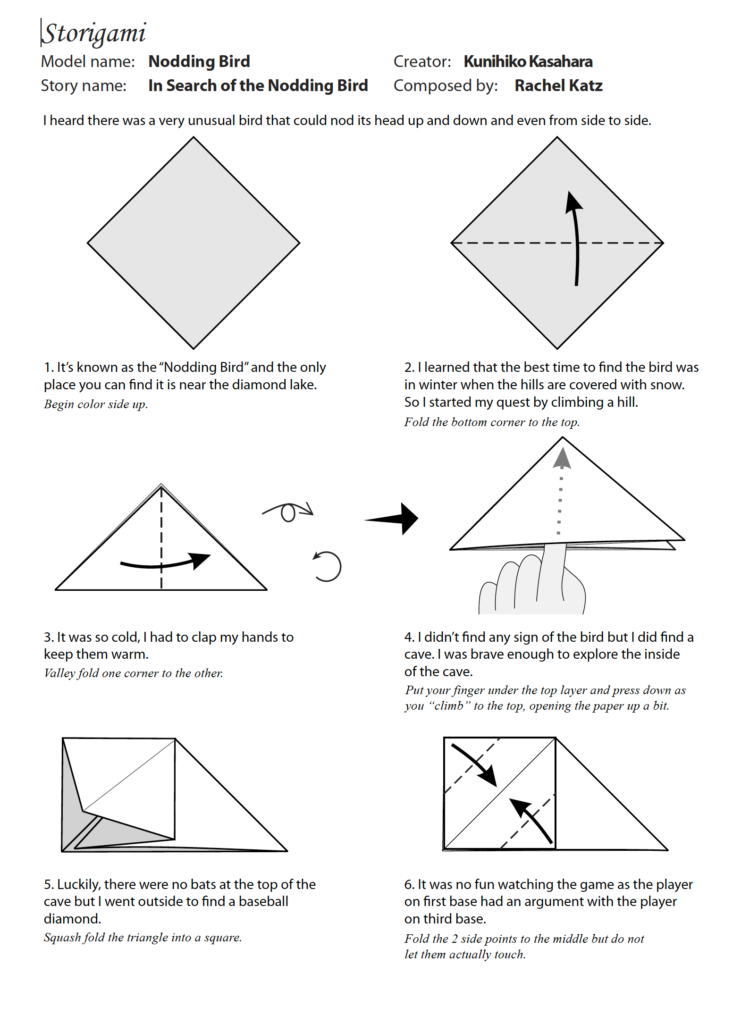Exploring Storigami.
- Introduction
The use of storytelling to enhance the academic success of students and involve student exploration has been long known [6,1]. Origami, encompasses elements from both arts and mathematics making it a valuable resource for supplementing and enriching the school mathematics curriculum and reading [9]. Now imagine merging storytelling and origami to come up with storigami. Very simply put, Storigami involves the telling of a story. The basic plot of the story incorporates the various folds and thus the telling of the story results in a finished origami model. Storigami is an innovative tool for teaching origami using a simple story, mnemonic or poem to engage the student, develop creativity, teach various subjects from the curriculum and in many cases help remember the folding sequence of an origami model.
In this paper, we show how we have created stories from simple origami models and used it to explore and further the scope of various subjects from the school curriculum.
- What are the benefits of Storigami?
The primary reason to use Storigami is to simplify the process of folding and memorizing the various abstract steps by a simple concrete story. The story progresses giving hints as to what the next step fold might be and this creates a truly complete learning experience. It also helps overcome the fear of origami, often perceived as a difficult and somewhat rigid art form.
Storigami benefits include;
• Storigami can be a useful interdisciplinary activity, which helps incorporate stories, origami and general subjects in the curriculum
• [2,3]Develops listening skills: Story telling engages most listeners and motivates them to follow the various steps leading up to the finished model
• [2,3]Visualization skills: The direct mapping of visuals of a story to the individual step folds of a model stimulates the right cerebral hemisphere functions of visualization and imagination.
• [2,3,7]Language comprehension skills: The way the words describe the scenes, actions and dialogs in the story interweave with the step folds of the model, providing tremendous opportunities for enhanced left cerebral hemisphere functions of language comprehension and expression.
• The process of remembering a simple story helping with the memory of the various steps helps with enhancing memory skills.
• [2,3] Storigami also helps with developing concepts such as symmetry, directions and dimensions. Phrases including terms like right, left, north, south, parallel helps to practice spatial relationships.
• Social skills: Storigami provides tremendous opportunity for creative thought, skills and experiences. Storytelling by students provides an excellent way to develop confidence [7] and public speaking skills.
- Who can use Storigami?
Teachers: Stories provide teachers a unique way to introduce various topics. Tying in origami to various parts of the curriculum is one of the primary focus of this paper.
Art Therapists: Stories provide a great way to get a child started on origami. We all know the educational benefits of origami. Stories greatly enhance and interest the art form of origami, thus making it more approachable.
Group Leaders: Origami can be a wonderful group activity. Stories make it all the more exciting and fun.
Storytellers: Using origami in story telling definitely allows for unusual props and audience participation.
- How does Storigami work?
Typically a story is made up to go in parallel with folding sequence of an origami model. These stories could be fiction, historic, mnemonics or poems. The approaches to storigami are usually different depending on the storyteller. Below are some we found either in conversation or experienced with some storytellers from around the world.
Rachel Katz, arts in education specialist in Long Island uses the word “model-driven” to describe her approach. She says, she finds a model she would like to teach and then comes up with a story. She also says that as an art teacher she always looks to incorporate other subjects in the curriculum with her stories and models (see examples in the Storigami and the curriculum section).
Christine Kallevig, author, art therapist and storyteller chooses a very literary approach to storigami [2][3][7].
Maedean Erb, storyteller in Cherokee nation, Oklahoma focuses on using traditional Cherokee stories to illustrate origami. She likes to emphasize the moral of these stories and really point out the triggers or key words that are vital in remembering the folding sequence.
Kang Myun, performer, teacher from Korea focuses on team building using team folding. Her very interactive sessions start out with storytelling and folding of a model which will ultimately be part of a collage. She breaks the class into teams and the teams together make models and help each other in the storigami. She also finds ways to give prizes with various goals during her classes. She finds it particularly useful in very large class sizes.
Gay Merrill Gross, author, storyteller from New York [10] likes to add an element of magic and enchantment to learning origami. Like in her story for teaching a simple box, “Brothers long and brothers short [10]”, she loves rhyming stories and has experienced that it makes learning origami more fun.
Miri Golan, teacher from Israel has found storigami works very well with troubled but talented kids.
Marla Mastin, associate professor in Educational Studies from Minnessota State university very much focuses on the mathematics of origami while story telling. Please see her paper [7] on “Storigami mathematics” to see how she also integrates other subjects while telling of the stories.
Shrikant Iyer, story teller and arts in education consultant from Long Island, New York focuses on writing stories, which tie in the models with topics of cultural significance. He also likes to create true drama with key moments by introducing twists, conflicts and resolutions when the model comes close to formation. He also likes to make plays out of the story thereby creating a true performance based entertaining and learning experience.
Even the telling of another’s story involves adding an element of the storyteller’s point of view or approach thereby making it ones own.
An example of one such approach is the story called, “The Gift”. This story uses the backdrop of mothers day to teach a traditional purse model. This story apart from incorporating a small holiday, also touches subjects helping others and genuine friendship. There is also an opportunity to make this into a play in a classroom.
Storigami 1: The Gift
-Shrikant Iyer
(paper recommended is to use regular letter size paper 8 by 11. Duo or pattern copied on one side works best)
A little boy, Chip was walking down Long Street, looking rather worried. Through the corner of his eye, he noticed his best friend Dot walking up on the other side.
He ran across to Dot and screamed, “Dot. Dot. Did you get something for mother’s day? I have walked up and down this street and haven’t found a thing.” Dot excitedly said, “Not Long Street, Chip. You should be in the new gift shop on Short street. That’s where I got my mom’s gift.”
Chip hurried to Short street and soon found the new gift shop which Dot had recommended. He was excited as he looked through the window and found nice things. He went up the little step into the store. He accidentally tripped on it and fell upside down. The kind people from two corners of the shop rushed to help little Chip. He was soon back on his feet and thanked everyone for helping him and ventured into the store looking for the gift.
Something on one of the shelves, caught his attention and he reached up to get it. But what he didn’t know was that his best friend Dot had sneaked into the store to help him and she was reaching for the same thing he was. They saw each other through the shelves and in the minor scuffle that happened, the item fell under the shelf.
Dot quickly grabbed the item as Chip ran to her. They both looked at the item and screamed in unison, “Perfect!!! She is going to love it!” Chip looked at the price tag and then reached into his pocket. He counted his money and cried, “Oh no. I’m a few dollars short.” Dot, being the good friend that she is, said, “Chip, Don’t worry. I will lend you the difference.” Dot reached into her pocket and Chip finally bought the gift for his mother.
Can you guess what the gift was?
A hat? NO
It was a beautiful purse!!!!


- Storigami and the curriculum
The use of storigami across the curriculum is fairly new. Many educators agree that origami greatly enhances the learning experience especially in the areas of language and math skills. Yuri and Dr. Katrin Shumakov [2,3] have done extensive work on how origami enhances the language side of the brain. Please see Dr. Heather Forest’s on her website [1] lists the benefits of storytelling which include language skills, imagination and sharing. The addition of origami and storytelling can cumulatively add up to a highly enriched learning experience.
We have been particularly successful in integrating storigami in the following aspects of the curriculum;
• Egypt: The $2 pant suit is a way of telling the story of Hatsheput (pronounced hat cheap suit), a true story of a pharoah’s daughter, who, during the bloodiest time in Egypt’s history, called herself a man and took control of her country promoting peace through trade.
• Nature Studies: Rainforest stories using frogs and snakes as well as stories about whales and penguins to teach about these animals and their habitats and also about ecosystems.
• Various math concepts and terms including fractions, measurement and proportion with several different models and stories. Marla Mastin [7] also uses the term storigami mathematics as she discusses several mathematical terms as she tells her story.
• Incorporate seasonal origami stories into learning more about the seasons and festivals. Good examples are pumpkin, ghost and bat models, which work well with autumn and Halloween themes.
• The traditional masu box to talk about measurement, problem solving as well as talking about Setsuban. This festival celebrated at the beginning of February is an attempt to clear away the evil. Children in Japan fill their boxes with soy nuts to throw at the “ghost of winter”. They keep one bean for each year plus one of their ages to eat hoping to bring good fortune for the year.
The use of storigami as an interdisciplary activity can be demonstrated by a simple story of the nodding bird. We have widely used this as a lesson in ecology and conservation.
Storigami 2: The nodding bird
-Rachel Katz
The delightful model in this story has action – making it attractive to children. This story has been used effectively for the upper elementary school grades.
Before telling this story, I introduce origami to the students by showing examples of origami made with scrap paper. Models like the spiky star made [8] with copy paper that has been printed on one side, trumpeting elephants from paper bags, and pencils made from the inside of business envelopes. Using old posters, maps, magazine papers, catalogue pages, junk mail and recycled old greeting cards etc. I show a very large envelope folded from a square cut from the poster. Opening it reveals a progression of smaller and smaller envelopes made from scrap paper from the list above.
Then, I indicate that the reason I reuse paper is that if we don’t take care of the earth, soon species that we are familiar with may become extinct. Then on to the fantasy…
I heard there was a very unusual bird that could nod its head up and down and even from side to side.
- It’s known as the “Nodding Bird” and the only place you can find it is near the diamond lake.
Place the paper down like a baseball diamond with the colored side up.
I learned that best time to find the bird was in the winter when the hills are covered with snow. So I started my quest by climbing a hill.
Fold the bottom corner to the top
- It was so cold that I had to clap my hands to keep them warm.
Fold one side corner over to the other to make a smaller triangle.
- I didn’t find any sign of the bird but I did find a cave. I was brave enough to explore the inside of the cave.
Put your finger under the top layer and press down as you “climb” to the top opening up the paper a bit.
- Luckily, there were no bats at the top of the cave but I came outside to find a baseball diamond.
Squash fold the triangle into a square.
- It was no fun watching the game as the player on first base had an argument with the player on third base.”
Fold the two side points to the middle but do not let them actually touch..
- So, since I was at the lake, I decided to take out a boat to look for the nodding bird.
Fold down the triangle that is on top to meet the one below that you made in step 6. Next, orient the paper to resemble a sailboat.
- Show the sailboat Unfortunately, there was no wind, and the boat hardly moved. My family must have felt sorry for me, because, the next thing I knew, they came along side in a speedboat.
Fold the triangle as shown, carefully folding almost nothing at the top but pulling the paper to the left and below forming the speedboat. Repeat behind.
- “The speedboat took me quickly away where I was met by a giant bird. “Oh, could you be the bird that can nod its head, I asked?”
Pinching with one hand beneath the head and the other on the lower dot, pull down and up on these point causing the head to nod.
- “Is it too difficult for us to learn to fold this origami bird?
Move your pinch a little higher (to the upper dot) so that you feel all the layers and move your thumb (or wrist if necessary) back and forth to make it move in a negative response.
So, if we become good custodians of the earth, many species will be around for a very long time.

Final notes on this model:
1.Point out that although the story is made up, clearing rainforests and otherwise destroying our planet is leading to the rapid loss of species, affecting climates and perhaps medicines which could have been derived from trees and other plants.
- If you have paper that is black on one side, it can be used as a penguin.
- The first model might be made with reused gift wrap or printed (on one side) flyers and after taking the students through the story step by step, give them smaller and smaller squares and let them make a whole family of birds. The students work on their own but are free to ask for help from one another. By the time they’ve made three of them, they’ve truly mastered the model and derived the self-esteem to pass it on.
- Use the opportunity to introduce mountain and valley folds; the squash fold symbol and the turnover arrow to familiarize the students with international origami diagramming symbols.
- Discuss ways that we all can help to be good custodians of the earth.
- Conclusion:
Storytelling to the presentation of origami further enhances the classroom activity and engages the student’s mind and creativity. It helps the child transition from abstract to concrete in a way most children are comfortable with. You can use the stories in this paper or come up with your own. How you present the story or integrate it with the curriculum is a process of evolution and different for each teacher/performer. Ultimately the results of tying storytelling and origami can truly enhance the learning experience in several ways and the potential for innovation, imagination, language skills and creativity is great.
Bibliography
- Heather Forest Ph.D, www.storyarts.org
- Kallevig, Christine. Fold-Along Stories: Quick and Easy Origami tales for beginners. StoryTime Ink. International, 2001
3.Kallevig Christine. Holiday Folding stories. StoryTime Ink. International, 1992
4 Shumakova E.R. Functional interhemispheric asymmetry of a brain in dynamics of bimanual activity at children 7-11 years old at origami training, (Ph.D. thesis), Publishing house of the Rostov State University, 2000, 186 pp., in Russian
5 Shumakova E.R., Shumakov Y.V. Folding-method of bilateral development (based on the art of origami) // “Scientific conference of the post-graduate students and competitors”. Publishing house of the Rostov State University, 1999, P. 36-37., in Russian.
6 Forest, Heather. “Storytelling in the Classroom: Concepts and Activities”, “Listening, Observing, Remembering, Practicing: An Ancient Way of Learning” www.storyarts.com
7 Mastin, Marla. “Storigami Mathematics”, Teaching Children Mathematics, Nov 2007
8 Katz, Rachel Origamiwithrachelkatz.com
9.Tubis, Cornelius. “On the effective use of origami in mathematics classroom” Tubis, Cornelius. Origami 4, 2009
- The family storytelling handbook
1st ed.
Anne Pellowski ; illustrated by Lynn Sweat.
Published 1987 by Macmillan, Collier Macmillan in New York,London .